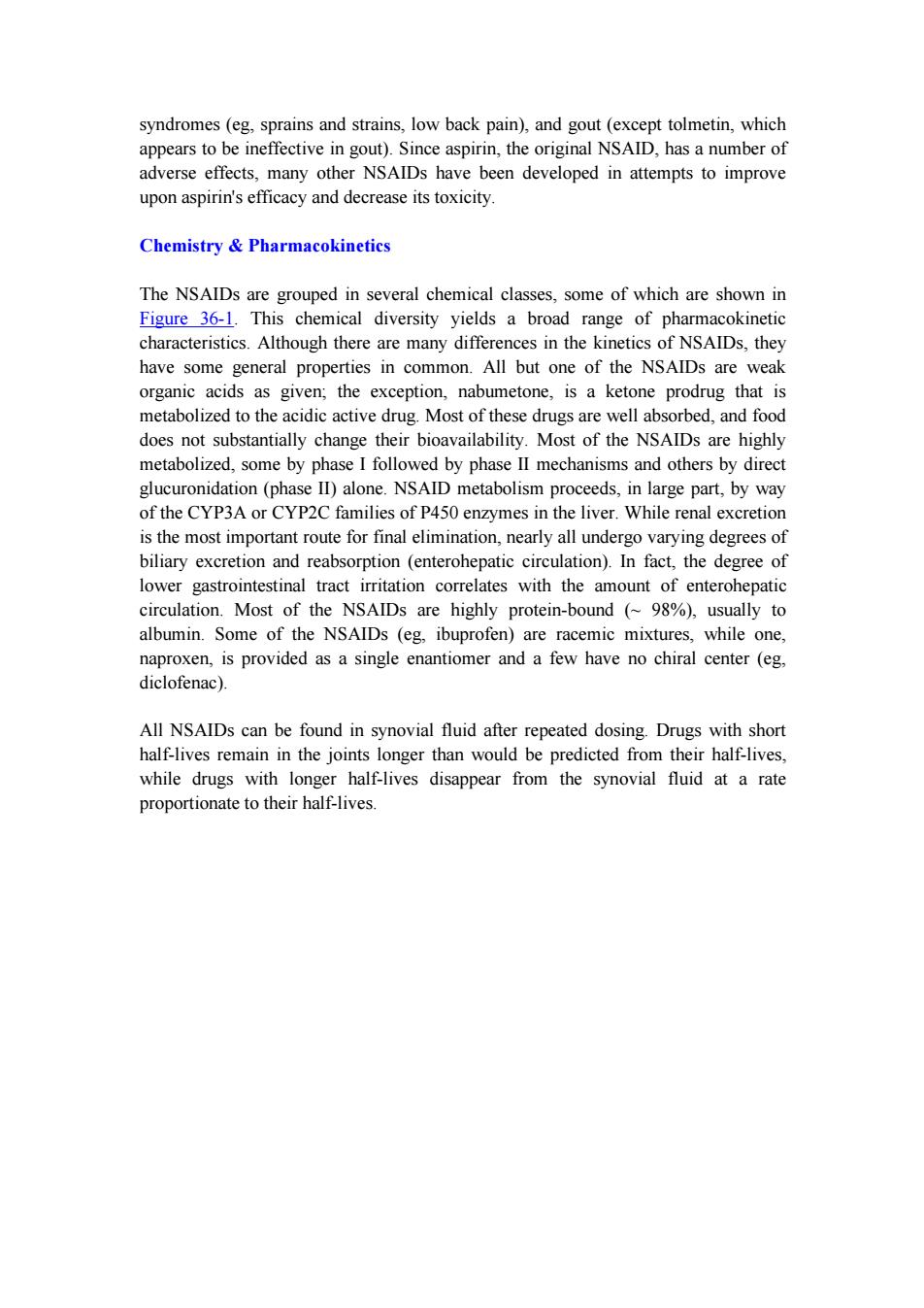正在加载图片...

syndromes (eg,sprains and strains,low back pain),and gout (except tolmetin,which appears to be ineffective in gout).Since aspirin,the original NSAID,has a number of adverse effects,many other NSAIDs have been developed in attempts to improve upon aspirin's efficacy and decrease its toxicity. Chemistry Pharmacokinetics The NSAIDs are grouped in several chemical classes,some of which are shown in Figure 36-1.This chemical diversity yields a broad range of pharmacokinetic characteristics.Although there are many differences in the kinetics of NSAIDs,they have some general properties in common.All but one of the NSAIDs are weak organic acids as given;the exception,nabumetone,is a ketone prodrug that is metabolized to the acidic active drug.Most of these drugs are well absorbed,and food does not substantially change their bioavailability.Most of the NSAIDs are highly metabolized,some by phase I followed by phase II mechanisms and others by direct glucuronidation (phase II)alone.NSAID metabolism proceeds,in large part,by way of the CYP3A or CYP2C families of P450 enzymes in the liver.While renal excretion is the most important route for final elimination,nearly all undergo varying degrees of biliary excretion and reabsorption (enterohepatic circulation).In fact,the degree of lower gastrointestinal tract irritation correlates with the amount of enterohepatic circulation.Most of the NSAIDs are highly protein-bound (98%),usually to albumin.Some of the NSAIDs (eg,ibuprofen)are racemic mixtures,while one, naproxen,is provided as a single enantiomer and a few have no chiral center (eg, diclofenac). All NSAIDs can be found in synovial fluid after repeated dosing.Drugs with short half-lives remain in the joints longer than would be predicted from their half-lives, while drugs with longer half-lives disappear from the synovial fluid at a rate proportionate to their half-lives.syndromes (eg, sprains and strains, low back pain), and gout (except tolmetin, which appears to be ineffective in gout). Since aspirin, the original NSAID, has a number of adverse effects, many other NSAIDs have been developed in attempts to improve upon aspirin's efficacy and decrease its toxicity. Chemistry & Pharmacokinetics The NSAIDs are grouped in several chemical classes, some of which are shown in Figure 36-1. This chemical diversity yields a broad range of pharmacokinetic characteristics. Although there are many differences in the kinetics of NSAIDs, they have some general properties in common. All but one of the NSAIDs are weak organic acids as given; the exception, nabumetone, is a ketone prodrug that is metabolized to the acidic active drug. Most of these drugs are well absorbed, and food does not substantially change their bioavailability. Most of the NSAIDs are highly metabolized, some by phase I followed by phase II mechanisms and others by direct glucuronidation (phase II) alone. NSAID metabolism proceeds, in large part, by way of the CYP3A or CYP2C families of P450 enzymes in the liver. While renal excretion is the most important route for final elimination, nearly all undergo varying degrees of biliary excretion and reabsorption (enterohepatic circulation). In fact, the degree of lower gastrointestinal tract irritation correlates with the amount of enterohepatic circulation. Most of the NSAIDs are highly protein-bound (~ 98%), usually to albumin. Some of the NSAIDs (eg, ibuprofen) are racemic mixtures, while one, naproxen, is provided as a single enantiomer and a few have no chiral center (eg, diclofenac). All NSAIDs can be found in synovial fluid after repeated dosing. Drugs with short half-lives remain in the joints longer than would be predicted from their half-lives, while drugs with longer half-lives disappear from the synovial fluid at a rate proportionate to their half-lives